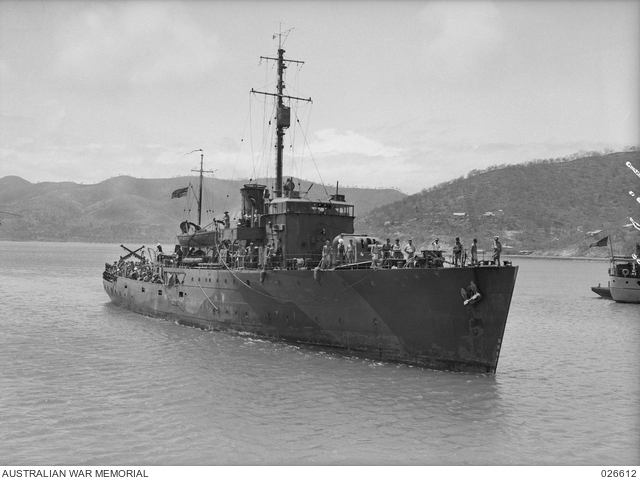A Cruel Sea - The sinking of HMAS Armidale
For Australians 1942 was the most perilous year of the Second World War. A series of victories brought Japanese forces into Australian territory in New Guinea and within a few miles of the Australian mainland. The bombing of Darwin in February heightened fears that an invasion was imminent.
HMAS Armidale in Port Moresby harbour after convoying troopships and supply vessels from Australia.
This exhibition marks the 60th anniversary of the sinking of HMAS Armidale. An important yet neglected episode in Australia's wartime history, the tragic story of the Armidale combines themes of bravery, sacrifice, and endurance. A hundred lives were lost when the ship went down, but in an extraordinary feat of survival, and despite continuing attacks from bombers and sharks, 49 men managed to survive at sea for up to eight days before being rescued.
A major feature of the exhibition is a series of ten large, dramatic pastel drawings, recently acquired by the Memorial. Drawing upon the memories of one of the survivors, Col Madigan, and the imagination of the artist, Jan Senbergs, the works emphasise the enduring significance of this event from a contemporary perspective.
Corvettes
Fifty-six corvettes were commissioned for service in the Royal Australian Navy during the Second World War. Originally designated "Australian Minesweepers", these smallest of Australia's warships performed wide-ranging service, including sea rescue, convoy escort, and supply and evacuation, in the Mediterranean, the Indian Ocean, the Persian Gulf, the South-West Pacific, and in Australian waters.
Named after Australian towns, corvettes were lightly armed and very crowded. Initially carrying between 60 and 80 men, the size of the crews increased as the ship's equipment became more sophisticated. At times, after carrying out a rescue or with troop transport, the number of men on these small vessels could swell to 300.
Armidale
HMAS Armidale was commissioned in Sydney on 11 June 1942. In November the ship was ordered, along with HMAS Kuru and Castlemaine, to resupply and evacuate troops and civilians from Betano Bay, Timor.
Spotted by Japanese reconnaissance aircraft as they left Darwin, Armidale and Castlemaine survived repeated air attacks but reached Betano too late to rendezvous with Kuru, which had already embarked Portuguese refugees and made for open water. The two corvettes found Kuru 110 kilometres off Timor and the refugees were transferred to Castlemaine, which then returned to Darwin. Kuru and Armidale were ordered to continue the operation in daylight. Both came under further attack and Armidale was sunk.
The survivors, having been strafed by the attacking aircraft, constructed a makeshift raft to which they lashed a half-submerged and badly-damaged whaler. The wounded were put aboard a small motor boat that had survived the sinking. When it became clear they would not be rescued, the captain and 21 other men (two of whom died) made for Australian waters in the motor boat, rowing much of the way because the engine was damaged. Two days later, another 29 survivors began the same precarious journey in the whaler, by now salvaged but in need of constant baling.
The remaining survivors clung to the raft and awaited rescue. After harrowing journeys the men in the motor boat and whaler were picked up, but the men left on the raft disappeared without trace.
The loss of life on the Armidale was the highest for any corvette in the Second World War. Only 49 of the 149 men on board survived the ordeal.
1942
In the early part of 1942 Japan's advance through south-east Asia brought its troops to within a few hundred kilometres of Australia. On 19 February Japanese aircraft bombed Darwin, and the next day its soldiers invaded Timor. Opposing them were Netherlands East Indies troops and two forces of Australians: Sparrow Force in Dutch West Timor and the 2/2nd Independent Company in Portuguese East Timor.
Fighting under the short-lived ABDA (American, British, Dutch, Australian) Command, the Allied forces were quickly defeated. Some members of Sparrow Force evaded capture and joined the 2/2nd Independent Company in a guerilla campaign against the Japanese in East Timor that lasted almost a year.
Elated Japanese troops after the surrender of British forces on Singapore Island.



